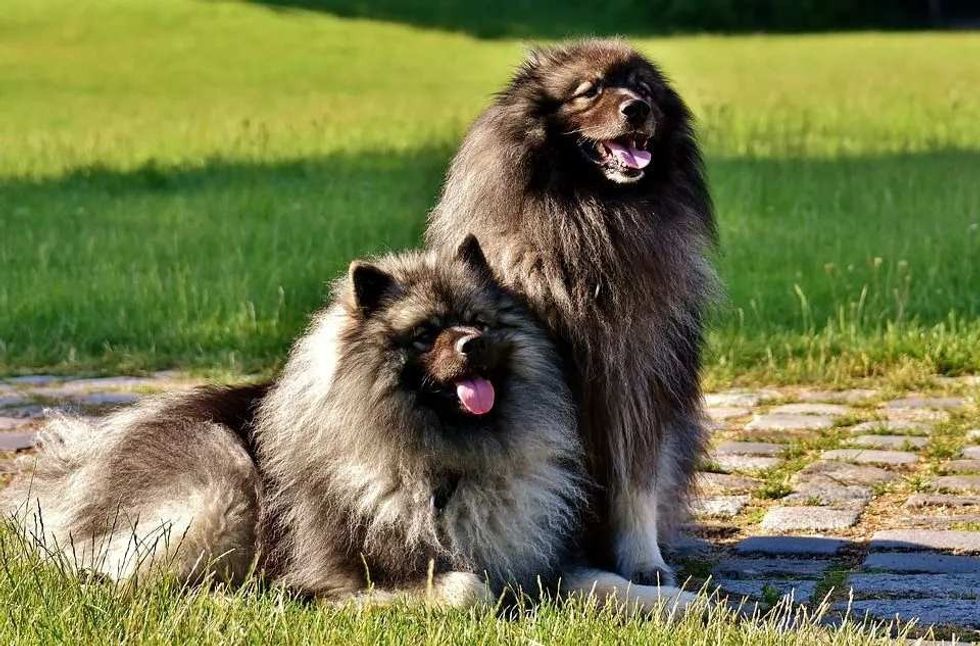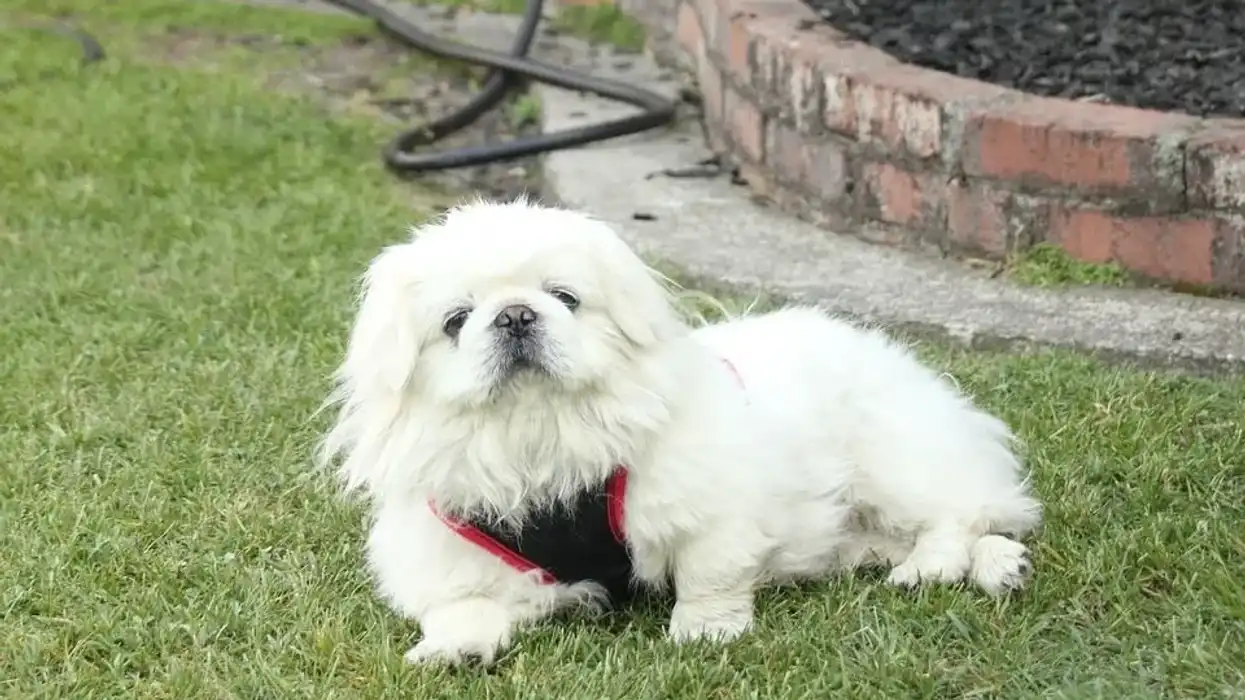The Keeshond dog breed, also known as the Dutch barge dog or smiling Dutchman is a medium-sized, non-sporting, family companion dog or watchdog which has a wedge-shaped head and is very friendly in the company of humans but it is not a good guard dog. According to the American Kennel Club, the Keeshond temperament is lively, active, and outgoing.
This dog breed is fluffy and has thick coat, which makes them adorable and loving. A pure-bred Keeshond puppy is difficult to find, and a Keeshond mix puppy with one parent being a Pomeranian, Samoyed, or Chow Chow is rather easily available.
Keeshonds are also used for their fur and are rescued from many dog shelters which indulge in such unethical businesses.
Their life span 12-15 years and require regular grooming and training sessions. They are well-behaved and require little training as they are involved in nonsporting activities.
The Keeshond dog, like any other medium-sized dog breed, is a man’s best companion and watchdog, but, again, it is not a good guard dog breed. Keeshonds are emotional dogs and love to be around human beings.
Research suggests that they suffer from separation anxiety when left alone for extended durations. After reading about the interesting Keeshond dog breed, do check out our articles on Japanese chin and Dogue De Bordeaux as well.
Keeshond Interesting Facts
What type of animal is a Keeshond?
Keeshond is a well-known dog breed which is commonly called the Dutch barge dog or smiling Dutchman, as the breed originated from Holland. The dog seems to grin because of the structure of its face.
Commonly these dogs are also called Kees. Keeshond makes for a great pet dog breed for its friendly temperament but requires regular training to be a good watchdog. The thick coat of a Keeshond dog demands regular brushing and grooming.
What class of animal does a Keeshond belong to?
The Keeshond belongs to the class of mammals who give birth to Keeshond puppies on completion of the gestation period.
How many Keeshonds are there in the world?
A good number of Keeshond dogs are bred in the Netherlands and Germany. Keeshonds can also be transported to other parts of the world if the weather and climate of the location are suitable for the breed to survive.
Where does a Keeshond live?
Keeshonds are pet dogs and create the perfect family environment with their presence. They are well-behaved and gentle around toddlers. They are excellent watchdogs but require intense training to be guard dogs.
What is a Keeshond's habitat?
Keeshond is a companion dog and can be kept as a pet which requires minimal training. A healthy house environment could be the best habitat for a Keeshond. A Keeshond is also a great watchdog that has the potential to scare away intruders. But its thick coat requires regular grooming thus necessitating human companionship.
Who do Keeshonds live with?
Keeshond is a great family pet and can live with human beings. The usual temperament of a Keeshond is very friendly, loving, and compassionate. They long for companionship and are one of the best pet dog breeds.
How long does a Keeshond live?
Keeshond life span 12-15 years is actually quite similar to other such dogs. They require regular grooming and should be fed with a diet consisting of low-carbohydrate concentration. Obese and ill-groomed Keeshond’s do not live till the average life span. Hence, proper attention must be paid to the grooming and training of these pet dogs.
How do they reproduce?
The male Keeshond mounts the female Keeshond, which is called the canine copulation. The gestation period then occurs for 63 days, after which the female gives birth to the puppy/puppies.
The number of Keeshond puppies in a litter can range between three to eight puppies.
The health of the female Keeshond also plays an important role in determining the litter size as well as number. If the mother is in a poor condition and suffers from multiple deficiencies, the Keeshond puppies will not survive after being born or will be born with abnormalities.
What is their conservation status?
Keesond is one of the dog breeds with 'Least Concern' conservation status.
Keeshond Fun facts
What do Keeshonds look like?
Keeshond dogs have a foxlike wedge-shaped face, upon which rests a friendly grin. They have certain marks near the eye region, which generates a prominent shape.
Keeshonds have very thick coat and love human touch. Keeshonds is one of the most active dog breed breeds that is lively and portrays a sporty personality. A Keeshond puppy super cute and adorable thanks to its innocent appearance and luscious coat.
How cute are they?
Keeshonds are extremely adorable and cute which can be reared as perfect family dogs. It has also been called a smiling Dutchman because of its grinning face. They have a thick coat which makes them fluffy and huggable. Their attachment and tenderness towards human beings also make them one of the most popular dog breeds.
How do they communicate?
Keeshonds both barks and whimpers with the help of multiple distinctive sounds. The Keeshonds also communicate in soft howls and whimpers or by physically touching the owner.
How big is a Keeshond?
The height of a Keeshond is usually 17-18 in, and it is usually smaller than a Samoyed or a Siberian Husky. The Keeshond’s weight and height also depend upon the health of its mother.
How fast can a Keeshond run?
The Keeshond is agile in nature and active. They need regular exercise to keep them from putting on weight which may cause obesity-related disorders like Patellar Luxation. They can run at an average speed.
How much does a Keeshond weigh?
On average, a Keeshond weighs between 35-40 lb. If your smiling Dutchman weighs more than the average weight, the owners must train them by involving them in exercises.
What are their male and female names of the species?
There are no different names for the male and female names of the Keeshond dog breed species.
What would you call a baby Keeshond?
The offspring of a Keeshond dog would be termed as a Keeshond puppy. There is not a scientific name for the baby of a Keeshond dog breed. On average, a healthy Keeshond would have four to five offspring, as the number of litter depends upon the breed of the dog.
What do they eat?
A Keeshond’s diet may include fruits, vegetables, fish. Generally, food that has low carbohydrates and fats can be fed to the Keeshond that will restrict the dog from gaining weight.
Food items which are eaten by human beings should not be fed to the dog as they have a sensitive digestive system which may cause a reaction in their stomach leading to diarrhea or in extreme cases death. Leafy vegetables and fruits can also be given to the dog only if prescribed by the vet.
Nutritious protein diets should be fed to such breeds, which will boost their immunity and keep the puppy healthy and energetic. The diet should be evened out in limited portions and must be controlled by the owner of the Keeshond.
Unnecessary meals in between the day should not be fed to the dog as this would result in an evident surge in the dog’s weight.
Do they shed?
Keeshonds are heavy shedders, and they shed excessively twice a year. The process of shedding is also called ‘blowing,’ where the Keeshond sheds all its undercoat during the period.
This shedding period can last up to three weeks, and it could be quite extreme. Keeshonds have a thick fur coat that should be brushed from time to time.
As the Keeshond doesn't have a tolerance for heat, during summers, some owners might think it is suitable that the coat of the Keeshond should be shaved. But this is not advisable, as the coat of the Keeshond protects its skin from intense heat and prevents it from sunburns.
Would they make a good pet?
Yes, Keeshonds make a good family pet as they are gentle with children and create a friendly environment. They belong to the breed of dogs which, according to history, were famous watchdogs in the Netherlands. They aren't good guard dogs because they are intolerant to loud noises.
Dog lovers can either adopt a Keeshond rescue dog left by previous owners or purchase new from an animal store. The Keeshond dog breed is comfortable around children and adults and loves to be surrounded by human beings.
Their usual temperament is playful and affectionate. They do not have extreme body odor, which is also an excellent reason to keep them as family pets.
If not brushed regularly, there is a high risk of matting the fur. It is important to note that Keeshonds are high-maintenance dogs and require an ample amount of attention.
Frequent visits to the veterinarian and grooming sessions should be done to keep the skin under the fur healthy, in order to wash away all the dead skin cells. The Keeshond must also be bathed to rinse off mites and ticks trapped in the fur of the dog. The fur of the dog must also be brushed regularly.
Since, the Keeshond is a dog breed with a thick layer of fur; it is possible that a little insect might infect the skin beneath the fur leading to skin infections. Worms, allergies, health conditions, and skin allergies are a major threat to this particular kind of dog.
It must be noted that the fur of the mammal should be brushed regularly, and the fur of the dog must be kept clean and rinsed with dog shampoos or cosmetics approved by the vet.
Did you know...
Keeshonds were used as watchdogs in the 17th century in Holland to keep an eye on the vessels and barges sailing upon the Rhine river.
The diet and weight of this breed should be controlled and regulated as they tend to put on weight which might lead to various health problems like difficulty in walking, lethargy, inactiveness, and other major diseases like patellar luxation, commonly known as a knee dislocation.
Hypothyroidism in dogs is also a common health problem that can potentially deteriorate their health.
Keeshonds are extremely loud and noisy. They are not friendly with strangers and can scare away an intruder easily. Their bark can be alarming for house owners who could suggest incoming potential danger. The Keeshonds are excellent watchdogs and guard dogs. According to their ease of trainability, the Keeshonds can be easily trained to be guard dogs.
Keeshonds are not at all aggressive. They are friendly with human beings and are playful with dogs. But if kept as a watchdog, the Keeshond will be trained in such a manner that it can bark excessively at a stranger. Keeshonds display a temperament that is amicable and affectionate.
How to train a Keeshond ?
Indulge the Keeshond into performing different exercises as well as making them follow basic instructions in the beginning. You can control the Keeshond by giving simple commands and analyzing these response.
Keep repeating the commands and instructions until they are registered in the memory of the mammal. Once the dog responds immediately to all the commands without any complication and the instructor is satisfied with the reaction, a new set of calls or orders can be taught.
How to pronounce Keeshond?
Kayz Hawnd or Kase Hawnd is the right way of pronouncing Keeshond.
Here at Kidadl, we have carefully created lots of interesting family-friendly animal facts for everyone to discover! Learn more about some other mammals including beaglier, or Brazilian terrier.
You can even occupy yourself at home by drawing one on our Kreeshond dog coloring pages.









